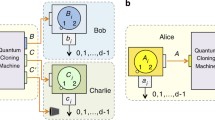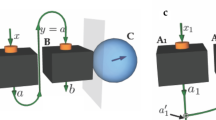Abstract
Bell non-locality and steering are archetypal characteristics of quantum mechanics that mark a significant departure from conventional classical notions. They basically refer to the presence of quantum correlations between separated systems which violate a non-local inequality, the violation otherwise is not possible if we restrict ourselves only to classical correlations. In view of the importance of such unique correlations, one may be interested to generate more states exhibiting non-locality starting from a few, a protocol which is termed as broadcasting. However, in the present submission, we show using universal Buzek–Hillary (BH) quantum cloning machine that, if one restricts to broadcasting through local quantum cloning, then such non-locality cannot be broadcasted. Our study is done in the purview of the Bell-CHSH inequality and the CJWR [E G Cavalcanti et al, Phys. Rev. A 80, 032112 (2009)] steering inequality. It is observed that when the number of measurement settings is greater than 6, some of the output states are steerable after the application of local optimal BH cloners. We found that, under some restrictions, if the Werner and Bell diagonal states are subjected to such procedures, then the resultant state is rendered unsteerable. We extended this study to three qubit systems and found that genuine tripartite non-locality cannot be broadcasted using universal BH local quantum cloners, when the Svetlichny’s inequality was considered. For two qubit systems, we considered \(10^5\) simulated general local unitaries over Werner and Bell-diagonal states and found that for none of these states, broadcasting on non-locality and 3-steerability is possible.
Similar content being viewed by others
References
J S Bell, Phys. Phys. Fiz. 1, 195 (1964)
N Brunner et al, Rev. Mod. Phys. 86, 419 (2014)
A K Ekert, Phys. Rev. Lett. 67, 661 (1991)
C H Bennett and G Brassard, Int. Conf. on Comp., Syst. and Sig. Process., Bangalore, India, 175 (1984)
R Uola et al, Rev. Mod. Phys. 92, 015001 (2020)
E Schrödinger, Math. Proc. Cambridge Philos. Soc. 31, 555 (1935)
M D Reid, Phys. Rev. A 40, 913 (1989)
H M Wiseman, S J Jones and A C Doherty, Phys. Rev. Lett. 98, 140402 (2007)
M D Reid et al, Rev. Mod. Phys. 81, 1727 (2009)
E G Cavalcanti et al, Phys. Rev. A 80, 032112 (2009)
M F Pusey, Phys. Rev. A 88, 032313 (2013)
C L Ren et al, Phys. Rev. A 97, 032119 (2018)
S P Walborn et al, Phys. Rev. Lett. 106, 130402 (2011)
J Schneeloch et al, Phys. Rev. A 87, 062103 (2013)
T Pramanik, M Kaplan and A S Majumdar, Phys. Rev. A 90, 050305(R) (2014)
Y N Chen et al, Phys. Rev. A 89, 032112 (2014)
M Zukowski, A Dutta and Z Yin, Phys. Rev. A 91, 032107 (2015)
H Zhu, M Hayashi and L Chen, Phys. Rev. Lett. 116, 070403 (2016)
W K Wootters and W H Zurek, Nature 299, 802 (1982)
V. Scarani et al, Rev. Mod. Phys. 77, 1225 (2005) and references therein
L M Duan and G C Guo, Phys. Rev. Lett. 80, 4999 (1998)
L Hardy and D D Song, Phys. Lett. A 259, 331 (1999)
V Buzek and M Hillery, Phys. Rev. Lett. 81, 5003 (1998)
V Buzek and M Hillery, Phys. Rev. A 54, 1844 (1996)
S Adhikari, B S Choudhury and I Chakrabarty, J. Phys. A: Math. Gen. 39, 8439 (2006)
N Gisin and S Massar, Phys. Rev. Lett. 79, 2153 (1997)
N Gisin, Phys. Lett. A 242, 1 (1998)
M K Shukla, I Chakrabarty and S Chatterjee, Quant. Inf. Process 19, 15 (2020)
H Barnum et al, Phys. Rev. Lett. 76, 2818 (1996)
V Buzek et al, Phys. Rev. A 55, 3327 (1997)
S Bandyopadhyay and G Kar, Phys. Rev. A 60, 3296 (1999)
I Ghiu, Phys. Rev. A 67, 012323 (2003)
S Chatterjee, S K Sazim and I Chakrabarty, Phys. Rev. A 93, 042309 (2016)
A Jain, I Chakrabarty and S Chatterjee, Phys. Rev. A 99, 022315 (2019)
R Mundra et al, Phys. Rev. A 100, 042319 (2019)
U K Sharma, I Chakrabarty and M K Shukla, Phys. Rev. A 96, 052319 (2017)
J F Clauser et al, Phys. Rev. Lett. 23, 880 (1969)
R F Werner, Phys. Rev. A 40, 4277 (1989)
G Svetlichny, Phys. Rev. D 35, 3066 (1987)
R Horodecki, P Horodecki and M Horodecki, Phys. Lett. A 200, 340 (1995)
R Horodecki, Phys. Lett. A 210, 223 (1996)
A A Ajoy and P Rungta, Phys. Rev. A 81, 052334 (2010)
A C S Costa and R M Angelo, Phys. Rev. A 93, 020103(R) (2016)
J Bowles et al, Phys. Rev. A 93, 022121 (2016)
R Mundra et al, Pramana – J. Phys. 95, 60 (2021)
Acknowledgements
Nirman Ganguly acknowledges support from the project grant received from DST-SERB (India) under the MATRICS scheme, vide file number MTR/2022/000101.
Author information
Authors and Affiliations
Corresponding author
Appendix A. Proof of Lemma 1
Appendix A. Proof of Lemma 1
Let
be a state of quantum system A. Also, let the blank state and the machine state be denoted as \(E_{a}\) and \(X_{x}\), respectively. Let \(U^{\mu }_{Aax}\) be a unitary operator applied on the joint system of A, a and x, and it defines the BH cloning machine with the machine parameter \(\mu \). After applying this cloning transformation to the joint system \(\omega _{\textrm{A}} \otimes E_{a} \otimes X_{x}\), we get the following output states \(\omega ^{\textrm{out}}_{\textrm{A}}\) and \(\omega ^{\textrm{out}}_{a}\):
Both the output states are the same as we are using a symmetric cloning machine. Intuitively, when we compare these output states with the input state \(\omega \), it is very interesting to observe that the vector associated with Pauli matrices is shrunk by the factor of \(\mu \). This observation is crucial for this proof.
Now, let us expand this development to the two-qubit case. As given, Alice (A) and Bob (B) share a state \(\rho _{\textrm{AB}}\), which is a general two-qubit state as written in (1). Additionally, let \(E_{a}\) and \(E_{b}\) serve as initial blank quantum states in Alice and Bob’s lab, respectively. Let us denote the machine qubits as x and y for Alice’s and Bob’s local cloning machines, respectively. Furthermore, they apply local cloning unitaries \(U_{Aax}^{\mu _{1}}\otimes U_{Bby}^{\mu _{2}}\) on their respective qubits, i.e., qubits (A, a, x) and qubits (B, b, y). Here, we assume that both the machine parameters, i.e., \(\mu _{1}\) and \(\mu _{2}\), need not be the same for generalising the approach. Let \({\tilde{\rho }}_{Ab}\) and \({\tilde{\rho }}_{Ba}\) be non-local output states obtained after cloning. Here, we only show for \({\tilde{\rho }}_{Ab}\) as we are using symmetric cloners, and therefore, we have \({\tilde{\rho }}_{Ab} = {\tilde{\rho }}_{Ba}\).
The equality (a) follows from the definition of a general two-qubit mixed state, the equalities (b) and (c) follow by expanding the expression and rearranging it for simplicity and the equality (d) follows from (A.1) and (A.2).
Rights and permissions
Springer Nature or its licensor (e.g. a society or other partner) holds exclusive rights to this article under a publishing agreement with the author(s) or other rightsholder(s); author self-archiving of the accepted manuscript version of this article is solely governed by the terms of such publishing agreement and applicable law.
About this article
Cite this article
Patel, D., Roy, A., Chakrabarty, I. et al. Broadcasting of non-locality. Pramana - J Phys 98, 59 (2024). https://doi.org/10.1007/s12043-024-02726-1
Received:
Revised:
Accepted:
Published:
DOI: https://doi.org/10.1007/s12043-024-02726-1




